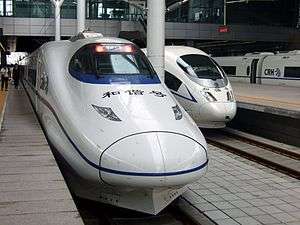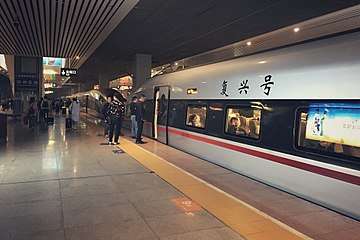G-series trains
G-series trains (Chinese: 高速动车组列车) are the fastest train services of China Railway. The trains usually run on dedicated high-speed railways with a designed top speed of 350 km/h (217 mph). The prefix "G" is pronounced as Gao in the CR system, which is short for Gaosu Dongche meaning high-speed EMUs in Chinese. The numbering of G trains are defined by the prefix G followed by a train number. Compared with D-series trains, G-series trains are operated at higher speeds for either part or whole of the journey, and if compared to the D trains sharing the route, may have fewer stops and even overtake these D trains by giving the latter a longer stay at some stations. G trains are also the only type of train that do not permit standees.
.jpg)
Rolling stocks
The G-series trains often use EMUs with a designed speed of 300 kilometres per hour (190 mph) or higher, covering both Hexie (CRH series) and the Fuxing (CR series).[1]
- CRH2C – The first type of high speed train running on ballast-free track. It is developed from CRH2A, which is based on the E2 Series Shinkansen from Japan
- CRH3C – A version of the Siemens Velaro high-speed train.

- CRH380 – Includes a series of EMUs: CRH380A and CRH380AL are developed from CRH2C. CRH380B, CRH380BG, CRH380BL and CRH380CL are variants of CRH3C. CRH380D is derived from Bombardier Zefiro.
- CR400 – It is divided into CR400AF and CR400BF. The CR series are also called as China Standardized EMU.
